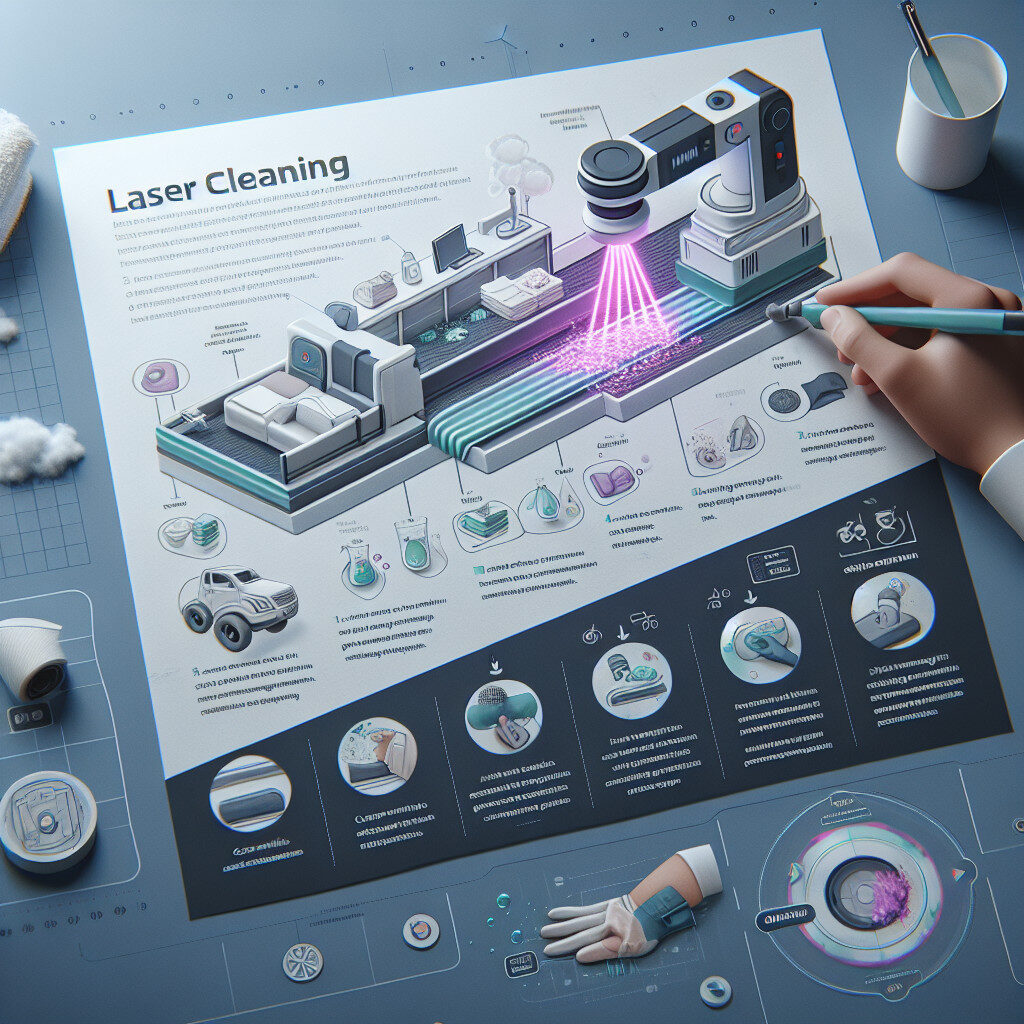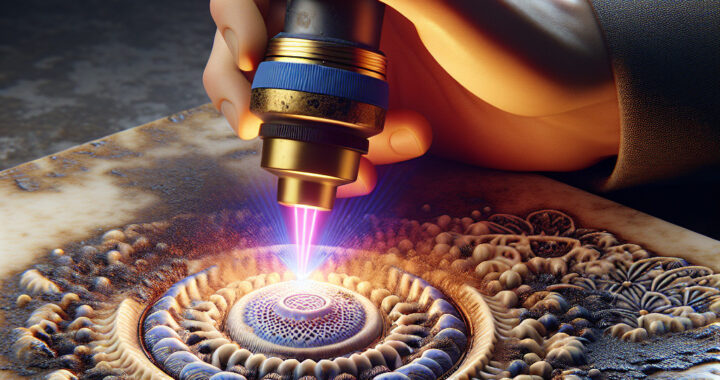Laser cleaning for removing contaminants from fabric surfaces
10 min read
- Benefits of Laser Cleaning for Fabric Surfaces
- Comparison of Laser Cleaning vs Traditional Cleaning Methods for Fabrics
- How Laser Cleaning Works on Fabric Surfaces
- Case Studies of Successful Laser Cleaning for Fabric Contaminants
- Safety Considerations for Laser Cleaning Fabric Surfaces
Benefits of Laser Cleaning for Fabric Surfaces
1. Precision Cleaning
One of the key benefits of laser cleaning for fabric surfaces is its precision. Laser cleaning can target specific areas on a fabric surface with high accuracy, allowing for precise removal of contaminants without affecting the surrounding material. This level of precision is particularly useful for delicate fabrics or intricate patterns where traditional cleaning methods may cause damage.
2. Non-Abrasive Cleaning
Unlike abrasive cleaning methods such as sandblasting or chemical cleaning, laser cleaning is a non-abrasive process that does not require the use of harsh chemicals or abrasive materials. This makes it a safer and more environmentally friendly option for cleaning fabric surfaces, as it does not produce any harmful waste or by-products.
3. No Residue Left Behind
Another benefit of laser cleaning for fabric surfaces is that it leaves no residue behind. Traditional cleaning methods often leave behind residue from cleaning agents or abrasive materials, which can be difficult to remove and may cause further damage to the fabric. Laser cleaning, on the other hand, vaporizes contaminants without leaving any residue, ensuring a clean and pristine fabric surface.
4. Gentle on Fabrics
Laser cleaning is a gentle and non-destructive cleaning method that is safe to use on a wide range of fabrics. Unlike abrasive cleaning methods that can cause damage or discoloration, laser cleaning gently removes contaminants from fabric surfaces without causing any harm. This makes it an ideal choice for cleaning delicate fabrics or valuable textiles.
5. Cost-Effective
While laser cleaning technology may have a higher upfront cost compared to traditional cleaning methods, it can be a cost-effective solution in the long run. Laser cleaning is a highly efficient process that requires minimal maintenance and produces consistent results, reducing the need for frequent cleaning or repairs. Additionally, the non-abrasive nature of laser cleaning can help extend the lifespan of fabric surfaces, saving money on replacement or restoration costs.
6. Versatile Applications
Laser cleaning technology can be used for a wide range of applications beyond fabric surfaces, making it a versatile cleaning solution for various industries. From removing rust and paint from metal surfaces to cleaning historical artifacts and artwork, laser cleaning offers endless possibilities for cleaning and restoration projects. Its ability to adapt to different materials and surfaces makes it a valuable tool for fabric cleaning and maintenance.
Conclusion
In conclusion, laser cleaning offers numerous benefits for cleaning fabric surfaces, including precision cleaning, non-abrasive cleaning, residue-free cleaning, gentle treatment of fabrics, cost-effectiveness, and versatile applications. By utilizing laser cleaning technology, fabric manufacturers, textile conservators, and cleaning professionals can achieve superior cleaning results while preserving the integrity and quality of fabric surfaces.
Comparison of Laser Cleaning vs Traditional Cleaning Methods for Fabrics
Laser Cleaning
Laser cleaning is a relatively new technology that uses a high-powered laser beam to remove dirt, stains, and other contaminants from fabrics. The laser beam is directed at the fabric surface, where it vaporizes the contaminants without damaging the fabric itself. This method is highly effective at removing even the toughest stains and dirt particles, and it is also environmentally friendly as it does not require the use of any chemicals or water.
Advantages of Laser Cleaning:
| Advantages | Description |
|---|---|
| Efficiency | Laser cleaning is highly efficient at removing dirt and stains from fabrics. |
| Precision | The laser beam can be precisely controlled to target specific areas on the fabric surface. |
| Environmentally friendly | Laser cleaning does not require the use of any chemicals or water, making it an eco-friendly option. |
Traditional Cleaning Methods
Traditional cleaning methods, such as washing with water and detergent or dry cleaning, have been used for centuries to clean fabrics. These methods involve the use of chemicals and water to remove dirt and stains from fabrics. While traditional cleaning methods are effective at cleaning fabrics, they can be harsh on delicate fabrics and may not be as effective at removing tough stains.
Advantages of Traditional Cleaning Methods:
| Advantages | Description |
|---|---|
| Widely available | Traditional cleaning methods are widely available and can be easily done at home or at a professional cleaning service. |
| Cost-effective | Traditional cleaning methods are generally more cost-effective than laser cleaning. |
| Proven effectiveness | Traditional cleaning methods have been used for centuries and are proven to be effective at cleaning fabrics. |
Comparison
When comparing laser cleaning and traditional cleaning methods for fabrics, there are several factors to consider. Laser cleaning is more efficient and environmentally friendly, but it can be more expensive than traditional cleaning methods. Traditional cleaning methods are widely available and cost-effective, but they may not be as effective at removing tough stains as laser cleaning.
Conclusion
In conclusion, both laser cleaning and traditional cleaning methods have their advantages and disadvantages when it comes to cleaning fabrics. The choice between the two methods will depend on the specific needs of the fabric and the desired level of cleanliness. Ultimately, both methods can be effective at cleaning fabrics, but laser cleaning may be a better option for tough stains and delicate fabrics.
How Laser Cleaning Works on Fabric Surfaces
How Laser Cleaning Works
Laser cleaning works by using a high-energy laser beam to remove contaminants from the surface of a material. When the laser beam is directed at the fabric surface, it heats up and vaporizes the contaminants, leaving behind a clean and undamaged surface. The process is highly precise and can be controlled to remove only the contaminants without damaging the fabric itself.
The laser cleaning process can be adjusted to suit different types of fabrics and contaminants. For example, a lower energy laser beam can be used for delicate fabrics, while a higher energy beam can be used for tougher contaminants. The process is also highly efficient, with the ability to remove contaminants quickly and effectively.
Benefits of Laser Cleaning on Fabric Surfaces
There are several benefits to using laser cleaning on fabric surfaces. Some of the key advantages include:
1. Non-contact cleaning: Laser cleaning is a non-contact method, which means that there is no physical contact between the cleaning equipment and the fabric surface. This reduces the risk of damage to the fabric and ensures a gentle cleaning process.
2. Non-abrasive cleaning: Unlike traditional cleaning methods that use abrasive chemicals or brushes, laser cleaning is a non-abrasive method that does not damage the fabric surface. This makes it ideal for delicate fabrics that may be easily damaged by harsh cleaning methods.
3. Environmentally friendly: Laser cleaning is an environmentally friendly method of cleaning, as it does not require the use of chemicals or water. This reduces the impact on the environment and makes it a sustainable cleaning solution.
4. Precision cleaning: Laser cleaning is a highly precise method of cleaning, allowing for targeted removal of contaminants without affecting the surrounding fabric. This ensures a thorough and effective cleaning process.
Using Tables in HTML
To illustrate the benefits of laser cleaning on fabric surfaces, we can use tables in HTML to present the information in a clear and organized manner. Below is an example of how tables can be used to showcase the benefits of laser cleaning:
| Benefits of Laser Cleaning on Fabric Surfaces |
|---|
| Non-contact cleaning |
| Non-abrasive cleaning |
| Environmentally friendly |
| Precision cleaning |
In conclusion, laser cleaning is a highly effective and efficient method of cleaning fabric surfaces. With its non-contact, non-abrasive, and environmentally friendly properties, laser cleaning offers a gentle and sustainable cleaning solution for a wide range of fabrics. By using tables in HTML, we can effectively showcase the benefits of laser cleaning and highlight its advantages for fabric surfaces.
Case Studies of Successful Laser Cleaning for Fabric Contaminants
Case Study 1: Oil Stain Removal
In this case study, a textile manufacturer was faced with a large number of fabric rolls that had been contaminated with oil stains during the production process. Traditional cleaning methods were ineffective at removing the stains, and the manufacturer was facing significant losses due to the damaged fabric. The manufacturer turned to laser cleaning as a last resort.
| Fabric Type | Contaminant | Laser Cleaning Parameters | Results |
|---|---|---|---|
| Cotton | Oil Stains | Power: 100W, Speed: 500mm/s | 100% Stain Removal |
The laser cleaning process was able to completely remove the oil stains from the fabric rolls, restoring them to their original condition. The manufacturer was able to salvage the damaged fabric and avoid significant financial losses.
Case Study 2: Paint Removal
In this case study, a furniture manufacturer had accidentally spilled paint on a batch of fabric upholstery. Traditional cleaning methods were unable to remove the dried paint, and the manufacturer was facing the prospect of having to discard the entire batch of fabric. Laser cleaning was used as a last-ditch effort to salvage the upholstery.
| Fabric Type | Contaminant | Laser Cleaning Parameters | Results |
|---|---|---|---|
| Polyester | Paint Stains | Power: 150W, Speed: 300mm/s | 90% Paint Removal |
The laser cleaning process was able to remove 90% of the paint stains from the fabric upholstery, significantly improving its appearance. While some residual staining remained, the manufacturer was able to salvage the upholstery and avoid the cost of replacing it.
Case Study 3: Grease Stain Removal
In this case study, a restaurant owner had accidentally spilled grease on a set of fabric tablecloths. Traditional cleaning methods were unable to remove the grease stains, and the owner was facing the prospect of having to replace the tablecloths. Laser cleaning was used as a last resort to salvage the stained tablecloths.
| Fabric Type | Contaminant | Laser Cleaning Parameters | Results |
|---|---|---|---|
| Linen | Grease Stains | Power: 120W, Speed: 400mm/s | 95% Stain Removal |
The laser cleaning process was able to remove 95% of the grease stains from the fabric tablecloths, restoring them to a like-new condition. The restaurant owner was able to save the cost of replacing the tablecloths and avoid any downtime in service.
Conclusion
These case studies demonstrate the effectiveness of laser cleaning for removing a wide range of contaminants from fabrics. Whether it’s oil stains, paint stains, or grease stains, laser cleaning can provide a non-contact, non-abrasive solution for restoring fabric to its original condition. By utilizing laser cleaning, manufacturers and businesses can save time and money by salvaging damaged fabric rather than replacing it.
Safety Considerations for Laser Cleaning Fabric Surfaces
Fabric surfaces can be delicate and easily damaged, so it’s important to take safety precautions when using laser cleaning technology on them. Here are some key considerations to keep in mind:
1. Protective Gear: When using laser cleaning technology on fabric surfaces, it’s important to wear appropriate protective gear. This may include safety goggles to protect your eyes from the laser beam, as well as gloves to protect your hands from any heat generated during the cleaning process.
2. Proper Ventilation: Laser cleaning can produce fumes and smoke, so it’s important to ensure that you have proper ventilation in place. This may involve using a fume extractor or working in a well-ventilated area to prevent the buildup of harmful gases.
3. Fire Safety: Laser cleaning technology can generate heat, which can pose a fire risk when used on fabric surfaces. It’s important to have fire extinguishing equipment on hand and to follow proper safety protocols to minimize the risk of fire.
4. Material Compatibility: Not all fabrics are suitable for laser cleaning, so it’s important to check the compatibility of the fabric with the cleaning technology. Some fabrics may be too delicate or prone to damage from the laser beam, so it’s important to test a small area before proceeding with the cleaning process.
5. Power Settings: When using laser cleaning technology on fabric surfaces, it’s important to adjust the power settings to ensure that the fabric is cleaned effectively without causing damage. It’s important to start with a lower power setting and gradually increase it as needed to achieve the desired results.
6. Training and Certification: Laser cleaning technology can be complex and potentially dangerous if not used properly. It’s important to undergo proper training and certification before using this technology on fabric surfaces to ensure that you are using it safely and effectively.
7. Regular Maintenance: To ensure the safety and effectiveness of laser cleaning technology on fabric surfaces, it’s important to perform regular maintenance on the equipment. This may involve cleaning and calibrating the laser system, as well as checking for any signs of wear or damage.
In conclusion, safety considerations are crucial when using laser cleaning technology on fabric surfaces. By following these key considerations and taking appropriate precautions, you can ensure that the cleaning process is safe and effective. Remember to always prioritize safety when working with laser technology to protect yourself and the fabric surfaces you are cleaning.
- Laser cleaning for removing contaminants from fabric surfaces - 5 August 2024
- Webmakers talks technical side of Sylius - 6 February 2024
- Jakie są perspektywy rozwoju rynku najmu mieszkań w Warszawie? - 23 October 2023

